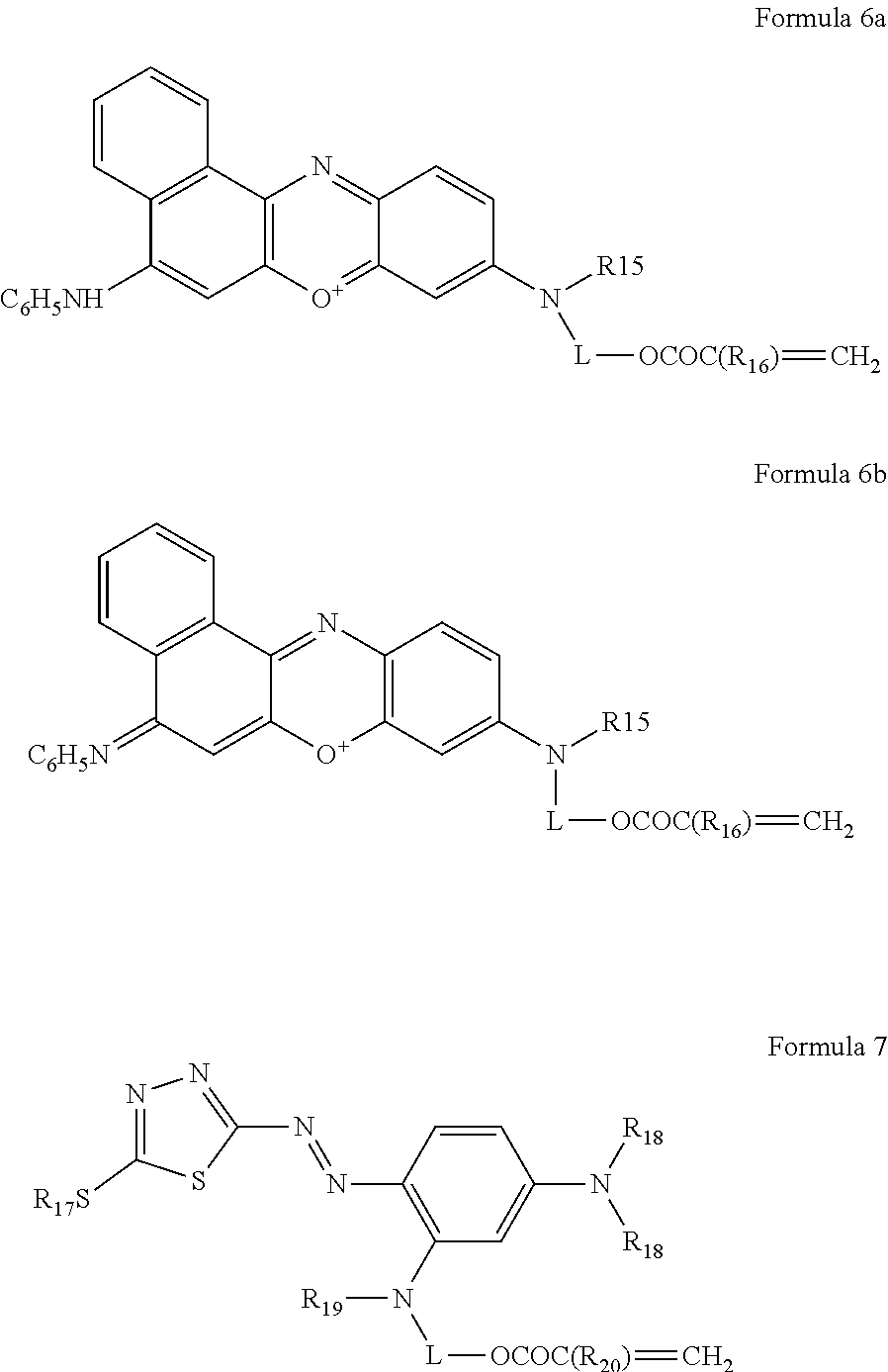Particles for electrophoretic displays
a technology of electrophoretic display and particle, which is applied in the field of particle electrophoretic display, can solve the problems of complex reported methods of preparing polymeric particles suitable for epd, lack of bright full colour system, and high cost, and achieve high monodispersity
- Summary
- Abstract
- Description
- Claims
- Application Information
AI Technical Summary
Benefits of technology
Problems solved by technology
Method used
Image
Examples
example 1
[3-{4-Ethyl-2[-(2-methylacrylolyloxy)-ethyl]amino}-phenylazo)phenyl] trimethylammonium Chloride (Yellow 4)
[0152]
[0153]Preparation of Coupling Component
[0154]
Stage 1. Preparation of 3-Amino-N,N,N-trimethylanilinium Sulphate
[0155]Dimethyl sulphate (50.45 g., 0.4 mol) is added dropwise to a stirred solution of 3-aminoacetanilide (15 g, 0.1 mol) in water (100 ml) at 50° C. at 50-60° C. pH is maintained at 7.5-8.5 with sodium hydroxide solution. The mixture is stirred for 16 hours at 50° C. after which a solution is formed. The solution is cooled to 5° C., sulphuric acid (specific gravity 1.83, 15 ml) is added and the mixture is heated to 100° C. and kept at this temperature for 3 hours. After cooling, the solution is made up to 150 ml and used as such, that is 0.01 m / 15 ml.
Stage 2. N-Ethyl-N-(2-methacryloyloxyethyl)aniline
[0156]Methacryloyl anhydride (18.5 g, 0.12 mol) is added dropwise to a stirred solution of N-ethyl-N-(2-hydroxyethyl)-aniline (16.5 g, 0.1 mol) in pyridine. The mixtur...
example 2
2-Methacrylic Acid-2-[ethyl-(5-phenylimino-5H-benzo[a]phenoxazin-9-yl)-amino]-ethyl Ester (Magenta 4)
[0158]
Stage 1. 2-[Ethyl(4-nitrosophenyl)amino]ethanol
[0159]2N Sodium nitrite is added dropwise to a stirred solution of N-ethyl-N-β-hydroxyethyl (16.5 g, 0.1 mol) in dilute hydrochloric acid, keeping the temperature below 5° C. and the pH at 1.5 to 2.0, until all of the starting material is consumed. Ammonia solution is added until the pH 9 is reached and the resulting oil is extracted with methylene chloride. Removal of solvent affords a greenish oil. Yield 16 g, 82%.
Stage 2. 9-[Ethyl-(2-hydroxyethyl)-amino]benzo[a]phenoxazin-7-ylium Nitrate
[0160]2-[Ethyl(4-nitrosophenyl)amino]ethanol hydrochloride (4.6 g, 0.02 mol) is made by adding gaseous HCl to a solution of 2-[ethyl(4-nitrosophenyl)amino]ethanol (0.02 mol) in diethyl ether. The solvent is decanted off and the freshly prepared compound is added portionwise, over 2 hours to a mixture of 2-naphthol (2.88 g, 0.02 mol) and zinc chlo...
example 3
3 / 4-Methyl-2-[4-{N-ethyl-N-(β-acryloyloxyethyl)phenylamino}phenylazo]-[1,2,4]-thiadiazolium Methosulphate (Magenta 3)
[0166]
Stage 1. N-Ethyl-N-β-acryloyloxyethyl Aniline
[0167]N-Hydroxyethyl-N-ethyl aniline is acylated in quantitative yield by stirring with methacrylic anhydride in pyridine, for 18 hours at ambient temperature. A small quantity of water is added to destroy excess anhydride and the reaction mixture is poured into water. The product is extracted into hexane and the organic layer passed through silica gel. On removal of solvent, product is obtained as a pale yellow oil which is used direct.
Stage 2. 2-[4-{N-ethyl-N-(β-acryloyloxyethyl)phenylamino}phenylazo]-[1,2,4]-thiadiazole
[0168]2-Amino-1,2,4-thiadiazole (2.02 g, 0.02 mol) is diazotised by stirring in a mixture of acetic acid and water and adding conc. sulphuric acid (2 g) followed by sodium nitrite (1.4 g, 0.021 mol). The mixture is stirred at 0 to 5° C. for 3 hours and excess nitrous acid is destroyed by adding a sma...
PUM
| Property | Measurement | Unit |
|---|---|---|
| Fraction | aaaaa | aaaaa |
| Fraction | aaaaa | aaaaa |
| Fraction | aaaaa | aaaaa |
Abstract
Description
Claims
Application Information
 Login to View More
Login to View More - R&D
- Intellectual Property
- Life Sciences
- Materials
- Tech Scout
- Unparalleled Data Quality
- Higher Quality Content
- 60% Fewer Hallucinations
Browse by: Latest US Patents, China's latest patents, Technical Efficacy Thesaurus, Application Domain, Technology Topic, Popular Technical Reports.
© 2025 PatSnap. All rights reserved.Legal|Privacy policy|Modern Slavery Act Transparency Statement|Sitemap|About US| Contact US: help@patsnap.com



